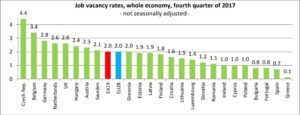:quality(80)/business-review.eu/wp-content/uploads/2015/06/unemployment.jpg)
The impressive economic growth Romania has been experiencing during the last few years has put increasing pressure on employers to find skilled workers in order to expand their businesses, but recent official data show Romania is far from being considered to be in a “workforce crisis” situation.
Eurostat, the European Union’s statistics office, showed on Friday that the job vacancy rate in Romania fell 0.2 percentage points year on year in the last quarter of 2017, to 1.1 percent, the eighth lowest rate among the 28 EU member states.
“Compared with the same quarter of the previous year and among the Member States for which data are comparable over time, the job vacancy rate in the fourth quarter of 2017 rose in twenty-three Member States, remained stable in Bulgaria and Spain, but fell in Greece and Romania (both -0.2 percentage points),” Eurostat notes.

This evolution is in sharp contrast with the impressive economic growth Romania experienced last year, posting a 7 percent GDP increase, the highest rate in the EU.
But experts warn that the structure of Romania’s economy and of the local workforce has a bad effect on employment.
“What kind of workforce are we talking about? Entrepreneurs complain they can’t find workers, but Romania has a low-tech economy with low wages, not very attractive for employees. In Bucharest, you’ll see announcements on shops’ windows everywhere: “We’re hiring retail staff!” But these are minimum-wage jobs,” Cristian Parvan, general secretary of AOAR (an employers’ association), told Business Review.
This retail workforce shortage is a consequence of the fact that much of the economic growth in Romania is the product of a consumer bonanza, stimulated by years of wage-led growth government policy.
But the real labour shortage is currently experienced in EU by the advanced economies, with sophisticated structures and high wages.
Among EU member states, the highest job vacancy rates in the fourth quarter of 2017 were recorded in the Czech Republic (4.4 percent), Belgium (3.4 percent), Germany (2.8 percent), the Netherlands and the United Kingdom (both 2.6 percent), according to Eurostat.
During the last few years, the Romanian government adopted a strategy of wage-led growth, stimulating household consumption and GDP growth rates, but this model has generated larger fiscal and current account deficits.
Many economists insist Romania should change its economic model in order to obtain real long-term economic and social development.



:quality(80)/business-review.eu/wp-content/uploads/2023/12/krzysztof-hepner-TH7TW20de9s-unsplash.jpg)




:quality(80)/business-review.eu/wp-content/uploads/2024/02/IMG_6951.jpg)

:quality(80)/business-review.eu/wp-content/uploads/2024/04/COVER-1.jpg)



:quality(50)/business-review.eu/wp-content/uploads/2023/07/Screenshot-2023-07-13-at-4.23.14-PM.png)
:quality(50)/business-review.eu/wp-content/uploads/2023/07/cardboard-at-mill.jpg)
:quality(50)/business-review.eu/wp-content/uploads/2022/02/Andrei-Brinzea-_Partner-Land-Industrial_Cushman-Wakefield-Echinox-sm-960x640.jpg)
:quality(80)/business-review.eu/wp-content/uploads/2024/04/cover-april.jpg)
:quality(50)/business-review.eu/wp-content/uploads/2024/04/Cisco-report.jpg)
:quality(50)/business-review.eu/wp-content/uploads/2024/04/BeFunky-collage-46-scaled.jpg)
:quality(50)/business-review.eu/wp-content/uploads/2024/04/Catalina-Burca-Andonie-Associate-si-Ionelia-Anton-Associate.jpg)